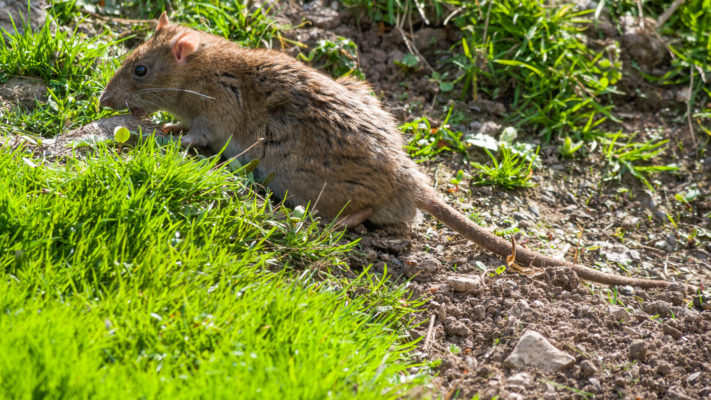We know a lot about the impacts of introduced mammal predators in wild environments and about how to control their numbers in forests and remove them entirely from uninhabited islands. What we don’t know so much about, is the lives and impacts those predators in places where people also live.

How can introduced predators best be managed in high density urban environments? What are the issues and challenges in removing them from inhabited locations? What don’t we know and what do we need to do better?
James Russell and Margaret Stanley from the University of Auckland have just published an overview of introduced predator management in inhabited landscapes. It’s published in Pacific Conservation Biology.
In inhabited landscapes, the benefits from removing predators may extend beyond helping native wildlife. There can be human health and agricultural benefits too.
“On larger islands, which also tend to be inhabited by people, managing introduced mammalian predators can be more challenging. In these contexts, the management (i.e. control or eradication) of invasive mammalian predators can bring about benefits much wider than those for biodiversity alone, including for agriculture and public health, although alongside potential perverse outcomes from increased native species, such as kaka damaging houses and trees.”
Up until now we’ve tended to focus conservation efforts on wilderness areas, but that’s changing.

“There has been a growing realisation that native biodiversity persists, sometimes even flourishes, in human-modified landscapes, and that most biodiversity will remain outside of protected areas. This has also meant that predator management in inhabited landscapes has become increasingly common and come under scrutiny.”
Many of our smaller offshore islands are now predator free. But new challenges have arisen with the remaining islands tending to be larger, with mixed land ownership and inhabited. Eradication is not just about the natural sciences involved. Social science – the ‘people factor’ – needs to be part of the predator management plan.
So what do we know about predators in inhabited environments and where are the information gaps?
“Much of the modern knowledge for landscape-level predator control on the main islands of New Zealand has come from the multi-decadal possum management research agenda and possums could likely be eradicated from the entirety of New Zealand using existing tools and technologies. Hedgehogs remain an understudied mammalian predator in New Zealand and are abundant in inhabited landscapes. There is currently a paucity of effective control tools for hedgehogs and they are generally overlooked as mammalian pests.”
Other common predators such as rats have also tended to be studied in wilderness areas rather than inhabited landscapes. A further challenge is understanding the impacts and roles of predator pets – the cats and dogs that live with us in significant numbers in towns, cities and rural habitations.

“Companion animals (cats and dogs) can reach extremely high densities in urban environments because of the prevalence of human ownership and subsidy. Cat ownership is estimated at almost half of New Zealanders. At the same time as being valued companion animals, these introduced mammals are also competent predators. A single cat can kill hundreds of animals in its lifetime outside its human subsidised diet and dogs are a major predator of adult kiwi in Northland. However, until recently, compared to other introduced predators little research has been undertaken in to the biology of companion animals as predators.”
Convincing pet owners to change their behaviour is just one example of the role social science can have in helping achieve natural science, conservation goals.
“Many proposed management measures are unpopular with cat owners, and cat owners have been found to be less likely than non-owners to support restrictions. Distinguishing owned from abandoned and stray animals is also difficult. The ownership and management of companion animals, thus, lies definitively at the interface between the natural and social sciences.”
So what is social science and what can it tell us?
“The social sciences enable research into human attitudes and the underpinning beliefs and values of humans towards predators, as well as the economics and politics of predator control, among other aspects of the human dimensions of predator management. Surveys have been used to understand the attitudes of people towards introduced mammalian pests. Attitudes to stray and feral cat management have also been undertaken. More recently, surveys have investigated the collaborative aspects of landscape pest control by private land owners.”
Social science can help build understanding about why people manage predators – and conservation is just one motivation.
“Although the focus on introduced mammalian predator management and biosecurity in New Zealand originated from agricultural and biodiversity protection, there is a growing emphasis on the non-biodiversity benefits. Although biodiversity protection may be a sufficient reason to support introduced mammalian predator management for some people, for others, the motivations to support management may be different. Management of introduced mammalian predators can bring several social, economic and public health benefits, among others. For this reason, introduced mammalian predator management should be seen within a wider remit of strategic environmental assessment.”
Predator management in inhabited landscapes can also be a potential cause of community conflict.
“In managing conservation conflict, ecological and social science make up only a small part of the resolution landscape. Without careful consideration, disagreements over management of invasive species can escalate rapidly.”
So who does that managing?
“Policy for introduced predator management is set out at the national and regional levels. Territorial authorities develop regional pest-management plans (under the rules of the Biosecurity Act) that set out the strategic and statutory framework for pest management within their regions.”
That’s the top-down system – but there is also a thriving volunteer conservation network at grassroots level.

“There has also been a rapid rise in collective action towards introduced mammalian predators in New Zealand, because it has become clear that predator management must also occur outside of government conservation lands (33% of New Zealand) and that the Department of Conservation is not sufficiently resourced to attend to all conservation needs. There are over 1000 community groups undertaking introduced mammalian predator control in New Zealand, alongside countless other private landowners.”
The extent of that effort is huge.
“Although the motivations to engage in such collective action are varied, across the main North and South islands of New Zealand, nearly half of the country receives some form of monitoring or management of introduced mammalian predators. However, the effectiveness of predator management in terms of outcomes for biodiversity is mostly unknown, particularly for community-led programmes.”
It’s not just about managing predators. Native species need a food-rich thriving habitat to live in.
“Predator management alone will not always restore populations of native species, and habitat quality is important. This is particularly so in lowland coastal areas of New Zealand, which have undergone the largest reduction in native habitat alongside rural and urban intensification. Exotic vegetation, such as pine plantations, provides appropriate habitat for some species, but must provide adequate food resources, while connectivity among native forest fragments can be a pathway for both native and exotic species.”
So what do we need to do?
“In inhabited environments, restoration of degraded forest sites must include all of the following: control of invasive weeds, control of pest animals, exclusion of stock, new or supplementary native planting, and removal of introduced canopy trees.”
There is much we still need to learn about managing predators in populated areas and the authors believe that there is a key role for conservation volunteers in adding to that pool of knowledge.
“Long-term studies in natural landscapes have produced some of the most important results for ecological management in New Zealand and such similar long-term studies in peopled landscapes would produce results of similar importance. The presence of many conservation-engaged citizens in inhabited landscapes, even if their primary motivation is not biodiversity conservation, creates unique opportunities to leverage citizen science in the pursuit of native biodiversity outcomes.”
The authors emphasise that it’s not just about counting the number of predators killed.
“Reduction in predator numbers is measured most easily by numbers of animals removed, and movements such as Predator Free New Zealand are motivated by the action of removing such predators. However, the ultimate goal of such actions is increases in abundance and diversity of native species.”
Predator management also needs to be on a sufficiently large scale to achieve that biodiversity impact.
“Pest control achieves such biodiversity outcomes only when its spatial and temporal scale reduces pest numbers below their damage threshold, which, at the same time, ethically justifies the animal welfare costs. Currently, much community predator control in New Zealand is motivated by factors such as civic participation. Although this raises awareness of the impact of introduced predators, more work is required understanding and setting standards for the biodiversity outcomes of such community projects.”
Then there are the non-biodiversity impacts.
“Knowledge of the non-biodiversity impacts of introduced mammalian predators, particularly on public health, is also rudimentary; however, impacts are likely to be high, particularly for invasive rodents (e.g. leptospirosis) and cats (e.g. toxoplasmosis). The interface between introduced mammalian predator control tools, and public acceptability (so called ‘social licence’), particularly concerning animal welfare, will always require ongoing investigation. Such research will be particularly important where social acceptability is unknown as new tools are developed. However, it may never be possible to fully resolve the disparity between animal and environmental ethics.”
How we compile social science data is also important to its ultimate usefulness.
“Surveys of attitudes linked to respondent demographics (e.g. age, gender, ethnicity) are informative, but they are more effective when they can be linked to other psychological traits of respondents, such as their trust in science, ideologies, and wider value orientations. Broader psychological studies in this form can identify the values underlying attitudes, and identification of archetypes of people independent of demography. Such studies acknowledge that there is no single ‘public’, and help develop conservation messaging targeted to particular archetypes, known as ‘conservation marketing’. It may turn out that appealing to values rather than evidence is more powerful in enacting conservation action.”

So where to now?
“As the number of predator control projects led by community groups continues to grow, greater attention must be given to monitoring both conservation and social outcomes from them and greater alignment in their strategy and the role they play nationally. Further research is also required on the psychology of group dynamics and conservation voluntarism, as participation in such community events creates a social dynamic with wider consequences.”
Then there’s the pet issue:
“Management of predatory companion animals continues to be a complex issue, although not necessarily intractable once initial emotional reactions are put aside. To that end, the New Zealand National Cat Management Strategy is a great example of a multi-stakeholder document. However, much more work is required to socialise the kinds of behavioural change that are recommended for responsible companion animal ownership.”
And let’s now forget the issues beyond predator control that also need to be addressed:
“Although introduced mammalian predators are one of the gravest threats to the animal subset of New Zealand’s native biodiversity, there are many other invasive species, and conservation threats (e.g. freshwater quality, land clearance and climate change), which must also be attended for New Zealand to achieve the sustainable biodiversity goals it aspires to. So, although advocating for greater research on introduced mammalian predator management in inhabited landscapes of New Zealand, we caution that this must be balanced against the priorities of other research investments.”
The full article is published in Pacific Conservation Biology. Only the abstract is freely available to non-subscribers.
An overview of introduced predator management in inhabited landscapes (2018)

